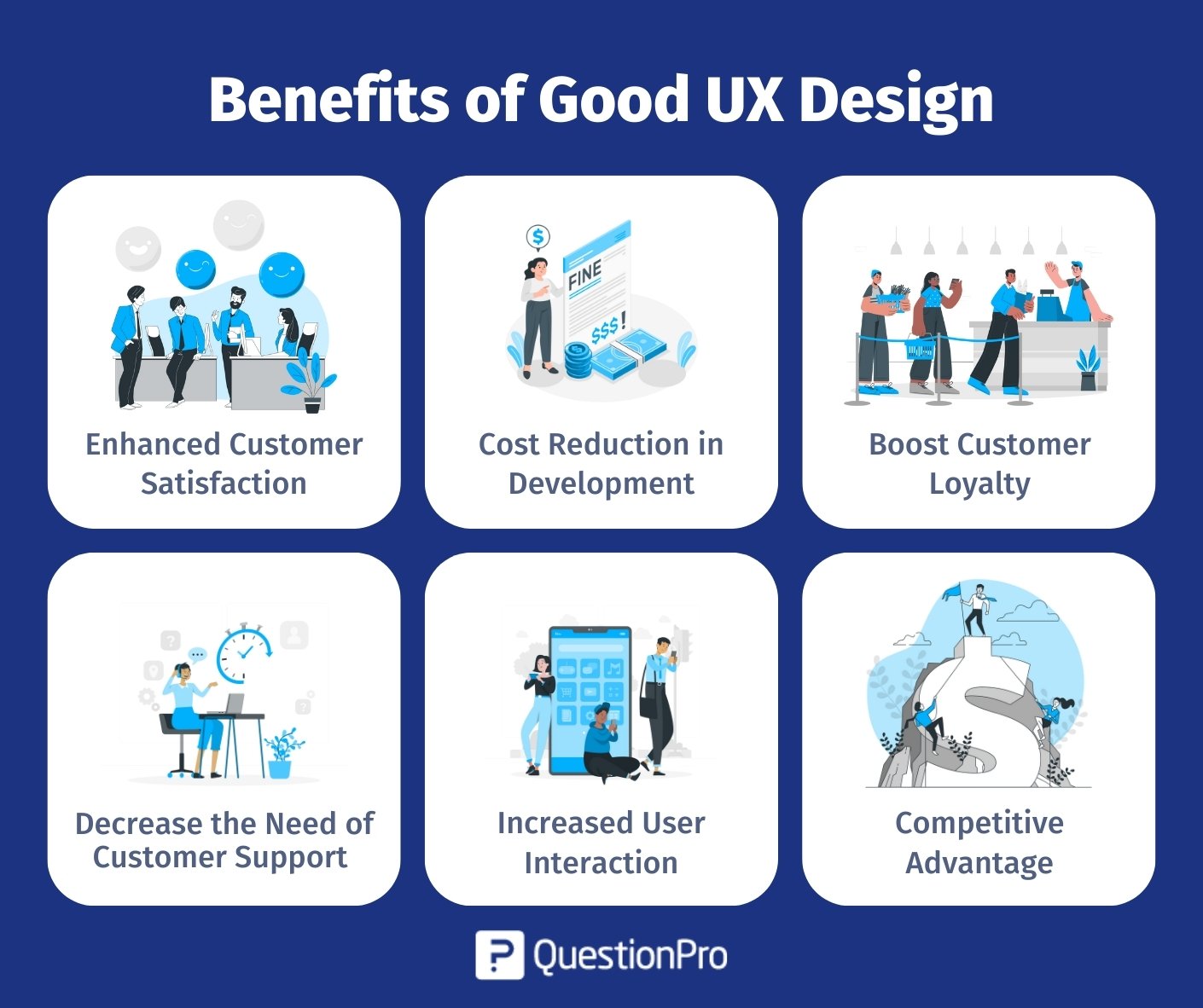
Tired of websites and apps that confuse and frustrate you? Ever wonder why some are so hard to use? You’re not alone – many face this problem in the digital world. The solution is user experience or UX design.
UX design is the magic that makes websites and apps smooth and easy to use. It ensures your digital journey is not just okay but enjoyable. Whether you’re a UX designer, a business owner, or just love easy digital experiences, this dive into UX design will spark your interest and change how you see the digital world.
Today, there are many sites and software to solve all kinds of problems, but not all of them are made with good UX design, and it is what defines which ones become big brands and which ones go unnoticed.
In this article, we will present to you what UX design consists of, what benefits there are in betting on this factor, and what elements you should consider when implementing it.
What is UX Design?
UX design is the process and approach to designing products and services that seek to improve the user experience through the product’s usefulness, aesthetics, and ease of use.
Good UX design keeps the user in mind and seeks to provide an easy and pleasant path when interacting with the product. It is mainly used in website development, e-commerce UX, and applications and can also consider aspects such as the pleasure and emotion generated by using the product.
UX designers work together with graphic designers, developers, and product managers to ensure that the things they create benefit the people who use them and help the business achieve its goals.
UX design keeps going even after the product is first released. Designers keep listening to feedback and making things better for the users. It’s really important for digital products, websites, mobile apps, and similar things to be successful.
Key Elements and Components of Good UX Design
User Experience (UX) design is driven by several key principles and components that are essential for creating compelling and enjoyable digital experiences. Here are the key principles and elements of UX design:
01. Focus on the User
UX design starts by understanding and prioritizing user needs, goals, and preferences. Remember that you’re not your user, so conduct research and create user personas to guide design decisions. Prioritizing user needs is essential for avoiding frustration and costly issues.
02. Simplicity
In terms of user experience, the main goal is simplicity, as this improves consistency and usability. By working hard on creativity and uniqueness, UX designers can unintentionally clutter the user interface design and even the product.
The “less is more” approach focuses on simplicity versus excessive interface decoration. Simplicity produces products that are easy to see and use.
03. Usability Matters
Usability is at the core of UX design. It measures how easily users can accomplish tasks within a product or service. If a product is usable, it indicates that its design, structure, and purpose are obvious and easy to understand.
The principle of web usability is at the heart of UX design since its main objective is to solve users’ problems. No matter how aesthetically pleasing your work is, it won’t resonate with users unless it is safe and easy to use.
The design has a direct and powerful impact on users and their conversions. UX designers or strategists have to conduct usability testing to ensure that every button, text, fragment, and element has a purpose and ensure that the user can easily reach it.
04. Consistency is Key
While unique design is tempting, consistency is vital for good UX. Users prefer familiar design patterns and elements. Consistency reduces confusion, enhances usability, and accelerates user learning. Using a shared design system saves time and money.
When a product is useful, it solves a user problem and satisfies a need. The design solves a problem that the UX designers knew about.
The difference between useful and usable is that usability refers to the product’s ability to work well and be easy to use. In contrast, usefulness refers to the product’s ability to solve the user’s problems directly.
05. Visual Hierarchy
Visual hierarchy is the way UX designers convey to the user the importance of the elements of a product through the organization of each one. It guides users to the most important elements on a page. It uses design principles like scale, color, and contrast to make key elements stand out, improving navigation and reducing friction points.
An excellent visual design helps users’ eyes move across the interface from the most crucial to the least gradual aspect.
06. User Control
User control is another design principle critical to UX research. Great UX design provides users with control.
Allow users to correct mistakes, go back, cancel, or undo actions. This enhances the overall user experience and aligns with the user control and freedom principle.
User interface controls that typically allow users to return to a previous state in the system include:
- Undo and redo options.
- A cancel link to abandon a task or multi-step process.
- A Back link to return to the previous page or screen.
- A link to close.
07. Design for Accessibility
Accessibility means ensuring everyone can use a system, even if they have trouble seeing, hearing, thinking, or moving.
When you design for accessibility, you’re helping people like yourself with various needs, such as physical, visual, hearing, or learning challenges. For a product to be successful, it needs to be usable, useful, and desirable.
Accessibility includes certain elements such as:
- Text readability.
- Adequate amount of contrast.
- Colors that everyone can see.
Benefits of Good UX Design
Good UX design offers a wide range of benefits for both users and businesses. Here are the key benefits of good UX design:

Enhanced Customer Satisfaction
Good UX design results from in-depth user experience research, information architecture, wireframing, prototyping, user testing, and integrating these elements into a solution.
This process restructures ideas and software to align with the real needs of end-users rather than assumptions. By understanding and meeting their actual needs, you can win their hearts and significantly increase customer satisfaction.
Cost Reduction in Development
Effective implementation of good user-centered design saves both time and money. A UX designer with excellent UX design skills can swiftly visualize and refine your ideas for testing and improvement. This proactive approach helps you avoid unexpected and costly changes later in the software development.
Boost Customer Loyalty and Retention
A positive user experience leads to happier and more satisfied users. Satisfied users often become brand advocates and enthusiastically share their positive experiences with friends and family.
Their satisfaction acts as free advertising, which is particularly valuable for startups looking to establish a reputable brand.
Decrease in the Need for Customer Support and Instructions
The more intuitive the UX and user interface (UI) design of a system, the less time users need to learn how to use a digital product’s functions and features. This reduces users’ need to spend valuable time reading and attempting to understand a user manual.
Consequently, your company can cut down on customer service costs since fewer users will require assistance in understanding how to use your digital product.
Increased User Interaction
An up-to-date UX design ensures that users can easily and enjoyably navigate your website or app. When users rate their experience as easy, intuitive, or valuable, they are more likely to engage with your company or brand in the future.
Competitive Advantage
Good UX design can be a significant differentiator in a crowded marketplace. It can set your product or service apart from competitors and attract more users.
User Research in UX Design
User research is a crucial part of UX design. It helps UX designers understand what users want and need. Designers can make better choices by studying how people behave and what they prefer. User research is a continuous learning process that helps UX designers improve what they create for users.
Methods of User Research
User research involves a wide range of methods and approaches for gathering relevant information about your users. Here are some commonly used methods:
- Surveys and Questionnaires: Surveys and questionnaires collect quantitative and qualitative data from a bigger user base. They help you get topic-specific input, analyze user satisfaction, and spot trends. Surveys are versatile user research tools that can be given online or in person.
- User interviews: One-on-one talks with participants offer deep qualitative insights. These discussions can reveal user motivations, issues, and needs. Open-ended questions and active listening help you comprehend the user’s perspective.
- Observational Research: Users are directly seen using a product or service. This method shows how users naturally use a system where they struggle and succeed. Observational research can assist in discovering usability problems and development opportunities.
- Card sorting: Card sorting shows how people organize information. It organizes content to match users’ mental models and creates an intuitive information architecture.
- Usability Testing: Usability testing involves seeing consumers do specified tasks in a product or prototype. This strategy gives rapid feedback on users’ interface use, where they struggle, and what works well.
- Eye Tracking: Eye tracking technology tracks screen focus. This method helps identify user interests, material reading habits, and visual efficiency.
Surveys and Questionnaires
Surveys and questionnaires are structured tools for gathering data from a larger group of users. You can use them to collect both quantitative and qualitative information. Here are some critical aspects of surveys and questionnaires in your user research:
- Scalability: Surveys and questionnaires can be distributed to many participants, making them suitable for collecting data from a broad user base.
- Quantitative Data: You can include closed-ended questions with predefined answer options, making it easy for you to analyze and quantify responses. This is useful for measuring your user satisfaction and identifying trends.
- Versatility: Surveys and questionnaires can cover various topics, from your user preferences and satisfaction to demographic information.
- Anonymity: You may feel more comfortable providing candid feedback in surveys, as you can remain anonymous.
- Structured Data: The structured nature of surveys and questionnaires can make them less suitable for exploring complex, nuanced issues compared to qualitative methods like interviews.
User Interviews
When you conduct user interviews, you’re engaging in a qualitative research method where you have one-on-one discussions with users. You ask open-ended questions to grasp better the user’s perspective, needs, and experiences. Here are some key points to consider when conducting user interviews:
- In-Depth Insights: User interviews provide deep insights into user motivations, behaviors, and emotions. They help you uncover the challenges and pain points users encounter when interacting with a product or service.
- Personalized Approach: Interviews offer a personalized research approach, letting participants express their thoughts and feelings in their own words. This can reveal needs that quantitative data may not capture.
- Flexibility: You can adjust your questions based on the participant’s responses, allowing you to explore unexpected topics that may arise during the conversation.
- Challenges: User interviews can be challenging because they require skilled facilitation to make participants feel comfortable sharing their experiences openly. Additionally, they can be time-consuming and resource-intensive, especially when you’re conducting interviews with many participants.
User-Centered Metrics
User-centered metrics are essential for evaluating your design’s user experience and effectiveness. These metrics will help you keep track of your product’s performance and make informed decisions. Here are some standard user-centered metrics that you might find helpful:
- Net Promoter Score (NPS): You can use NPS to gauge user satisfaction and loyalty. Ask your users how likely they are to recommend your product to others, and you’ll get a numerical score that tells you what users think.
- Task Success Rate: To see how well users complete specific tasks in your product, measure the success rate. High task success rates mean your product is easy to use and effective.
- Conversion Rate: In e-commerce and web design, you can measure the conversion rate to determine the percentage of users who take a desired action, like purchasing or signing up for a newsletter.
- User Retention Rate: To understand if users continue to find value in your product over time, assess the user retention rate. A high retention rate is a good sign.
- Click-Through Rate (CTR): Calculate the click-through rate to evaluate the effectiveness of call-to-action buttons or specific links. It’s the ratio of users who click on an element to the total number who see it.
Post-Launch Evaluations
After your product or service has been released to the public, it’s time to conduct post-launch evaluations. The primary goal of post-launch evaluations is to gather insights about user experiences, measure the design’s success, and identify improvement areas. Here are some essential activities you should consider:
- Review User Feedback: Take a close look at the feedback users have given you through surveys, interviews, and feedback forms. This will help you understand what’s working and what needs improvement.
- Monitor User Metrics: Monitor user-centric metrics to see how your product performs. Look for user behavior or satisfaction changes, which can guide your improvements.
- Iterate Your Design: Use the insights you gain from post-launch evaluations to make small, iterative design improvements. This is how you can fix issues and enhance the user experience over time.
- Try A/B Testing: Conduct A/B tests to compare different design elements or features and determine which version works best for your users. This way, you can make informed design decisions.
- Gather User Surveys: Send out surveys regularly to collect ongoing feedback. This will help you stay in tune with changing user preferences and needs.
How QuestionPro Helps in UX Design?
QuestionPro is a versatile research and survey software that can be valuable in the UX design process. It offers several features and capabilities that can aid UX designers in gathering user insights, conducting research, and improving their designs. Here’s how QuestionPro can help in UX design:
- Feedback Collection: QuestionPro allows UX designers to create surveys and questionnaires to collect user feedback. This feedback is invaluable for understanding user preferences, pain points, and expectations.
- User Research: With QuestionPro, a UX designer can conduct in-depth user research by creating surveys and questionnaires tailored to research objectives. They can gather insights about user behavior, motivations, and needs.
- Usability Testing: The software can be used to design surveys or questionnaires that help facilitate usability testing. Usability testing can provide real-time feedback on how users interact with a product, identify usability issues, and gauge user satisfaction.
- Qualitative and Quantitative Data Analysis: The software provides robust tools for analyzing qualitative and quantitative data gathered from user surveys. UX designers can utilize features such as data visualization, statistics, and reporting to derive insights from the collected data.
- User Segmentation: A UX designer can segment survey respondents based on various criteria, such as demographics, behavior, or preferences. This segmentation helps in tailoring the user experience to different user groups.
- Real-Time Feedback: The software offers the advantage of real-time feedback collection. A UX designer can access data as it’s collected, which enables them to respond promptly to emerging issues or trends.
- Mobile Responsiveness: QuestionPro surveys and questionnaires are mobile-responsive. It ensures users can provide feedback through various devices, including smartphones and tablets.
- Integration with Other Tools: QuestionPro can integrate with other software and tools commonly used in UX design, such as data analysis software, customer relationship management systems, and project management tools.
Final Words
UX design is about understanding what people need and want when using a product or website. It’s not just about how things look but also how they feel and how easy they are to use. When UX designers focus on making things that users love, it leads to happy users. And happy users mean more people using and liking a product or service.
UX design isn’t just about creating something pretty; it’s about making sure it’s easy for everyone to use, regardless of limitations or disabilities. It’s about making technology that people can trust and enjoy using.
Whether you’re a user experience designer, a business owner, or just someone who uses digital stuff, UX design helps create things that are useful, fun, and easy to use. In today’s tech world, UX design is the key to making sure technology works for people, not the other way around.
Remember that with QuestionPro, you can have multiple tools at your fingertips to evaluate your UX design, from using surveys on your website to implementing A/B tests, focus groups, and much more.
If you want a free trial, contact us at the link below!







